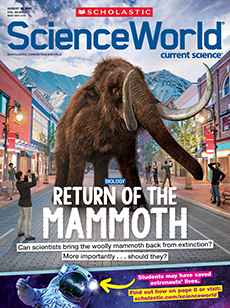The planet is warming, and as it does, part of its history is melting away. Global warming, the increase in the average temperature of Earth’s atmosphere, is causing glaciers to disappear. These large, slowly moving masses of ice can contain water that’s been frozen for more than 5 million years. Glaciers are like time capsules, holding clues about what Earth’s climate was like long ago.
Since the mid 20th century, scientists have drilled into glaciers to collect samples called ice cores. Researchers study the chemical composition of these rods of ice. Doing so can provide information about what Earth’s atmosphere was like long ago, such as its past gas composition, temperatures, and amounts of precipitation. But “as glaciers melt, these records potentially get destroyed,” says Bradley Markle, a climate scientist at the University of Colorado Boulder.
By studying ice cores, Markle and other scientists have learned that Earth’s climate has gone through periods of warming and cooling throughout history. Understanding the conditions during these periods allows scientists to re-create a detailed picture of historical climate shifts. Researchers can compare these natural shifts to the dramatic human-made climate change we’re experiencing today. That’s why scientists are racing to collect ice cores—and the valuable data they contain—from glaciers around the world, before they’re gone for good.
The planet is warming, and part of its history is melting away. Global warming is the increase in the average temperature of Earth’s atmosphere. It’s causing glaciers to disappear. These are large, slowly moving masses of ice. Some water in glaciers has been frozen for more than 5 million years. Glaciers are like time capsules. They hold clues about Earth’s climate long ago.
Scientists began to collect samples called ice cores in the mid-20th century. They drill into glaciers to remove these rods of ice. Then researchers study their chemical composition. That provides information about Earth’s atmosphere long ago. For example, it can show gas composition, temperatures, and amounts of precipitation in the past. But “as glaciers melt, these records potentially get destroyed,” says Bradley Markle. He’s a climate scientist at the University of Colorado Boulder.
Markle and other scientists have studied ice cores and learned about changes to Earth’s climate. The planet has gone through periods of warming and cooling throughout history. Scientists want to understand the conditions during these periods. Then they can re-create a detailed picture of past climate shifts. Researchers can compare these natural shifts with today’s dramatic human-made climate change. That’s why scientists are racing to collect ice cores from glaciers around the world. They want to gather the valuable data in the ice before it’s gone for good.

